Abstract: Two new types of digital-to-analog converters (DACs) from Maxim can provide higher dynamic characteristics for communications and instrumentation systems. The MAX5886 / MAX5887 / MAX5888 12-bit to 16-bit converters maintain high sampling rates and low power consumption At the same time, it has excellent dynamic characteristics; the 14-bit converter MAX5195 is the one with the widest dynamic range among the 260Msps sampling rate products. Both chips are available in small size and surface mount packages. These DACs also support multi-carrier UMTS, CDMA and GSM.
The higher information bandwidth necessary for modern communication systems to exchange digital information is achieved through a variety of modulation and coding methods, which require wider dynamic characteristics in the transmitter signal processing link. Applications such as UMTS, cdma2000®, and GSM / EDGE also require high dynamic performance, and they are close to the requirement of synthesizing multiple carriers from a single signal generating source.
UMTS requires up to four carriers per transmitter. A single transmitter for GSM / EDGE and cdma2000 may require four to eight carriers. Multi-carrier synthesis requires that the signal channel has a sufficiently wide dynamic range. As the source of this complex modulation waveform, DAC has become a performance bottleneck in the signal path.
UMTS base stations are currently introducing multi-carrier signal synthesis. Therefore, these base stations require the DAC to meet the UMTS standard and leave sufficient surplus. The use of DAC in this application also includes correcting the nonlinearity of the power amplifier by introducing digital predistortion into the signal. This aspect alone will increase the bandwidth requirements of the DAC by three to five times. In this way, the signal bandwidth of four UMTS carriers (up to 100MHz) requires a higher sampling rate and a higher analog output frequency. The MAX5888 with a 500Msps refresh rate is designed for this application. The device's performance definition exceeds the UMTS specification requirements for up to four UMTS carriers.
The accuracy and signal bandwidth of this DAC are also competent for communication systems using high-order QAM. Modulation up to QAM256 requires a wider dynamic range to accurately generate the modulation waveform.
The transmission waveform of the GSM / EDGE system even requires the DAC to provide higher dynamic performance. The synthesis of multi-carrier signals pushes the requirements of SFDR, IMD and SNR to the limit. For these demanding applications, MAX5195 can provide the industry's highest SFDR, SNR and IMD. The generation of instrument signals in DDS applications also requires excellent dynamic performance of the DAC. The MAX588X series (MAX5886 / MAX5887 / MAX5888) and MAX5195 are very suitable for this application. Advantages of the MAX588X series and MAX5195 The DACs of the MAX588X series can provide excellent dynamic performance at a very low power consumption level, with the industry's leading 500Msps maximum sampling rate. At 50MHz output frequency and 400Msps refresh rate, the SFDR of the MAX5888 exceeds 67dBc. In addition, it has excellent SNR (-155dB / Hz) and dual tone IMD (-72dBc) at an output frequency of 80MHz. These characteristics are obtained at a sampling rate of 500Msps, a single 3.3V power supply and very low power consumption (235mW).
Digital data is fed in through the LVDS interface, which has two benefits: LVDS logic can very efficiently support the 500Msps data rate, and the differential input digital signal also helps reduce system noise on the digital interface. This is especially important when designing systems with a wide dynamic range.
The dynamic performance of the MAX588X series is only inferior to the newly introduced MAX5195, as shown in Figure 1, the latter's performance surpasses any other commercially available devices. In addition to its excellent SFDR performance, its SNR also leads the industry at -160dB / Hz, and its dual-tone IMD (87dBc at 32MHz output frequency) is also excellent. The digital interface of this 14-bit DAC is LVPECL, which is similar to LVDS, and also reduces the system noise caused by high-speed digital data transmission.
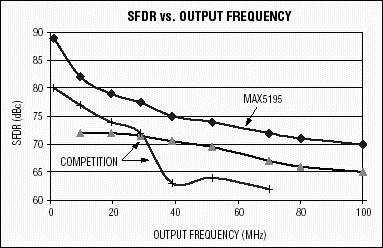
Figure 1. This SFDR curve compares the MAX5195 with the best competing devices in a certain output frequency range.
All these DACs are available in small QFN packages: the MAX588X series is 68-pin and the MAX5195 is 48-pin. The leadless QFN package has both small size (7mm x 7mm) and good thermal and electrical performance. The exposed pad provides ultra-low ground impedance, which further reduces spurious signals in the output signal. How can these DACs be used in other applications? Let's examine the application of multi-carrier UMTS using digital predistortion technology. This application requires high dynamic performance and a signal bandwidth of 100MHz. The UMTS model for stray radiation requires that the stray components are not greater than -58dBc within the 1MHz measurement bandwidth. Figure 2 shows the output spectrum at 300Msps sampling rate and 60MHz tone output. Devices such as the MAX5888 have sufficient margin in the 100MHz bandwidth of interest (more than 8dB beyond the mask requirement), leaving enough margin for each link in the transmit signal link. Spread spectrum signals can further reduce spurious output and provide more margin for design specifications.
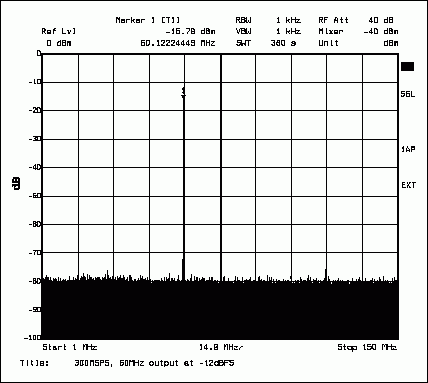
Figure 2. Typical SFDR of MAX5888, shown as 60MHz output frequency and 100MHz bandwidth.
Another important indicator for this application is the adjacent channel power ratio (ACPR). Figure 3 shows the spectral response of a single carrier UMTS with the carrier aligned at 60MHz. It can be seen that it fully complies with the requirements of the ACPR template for the first and second adjacent channels (-45dBc and -50dBc), and has a loose margin of over 25dB.
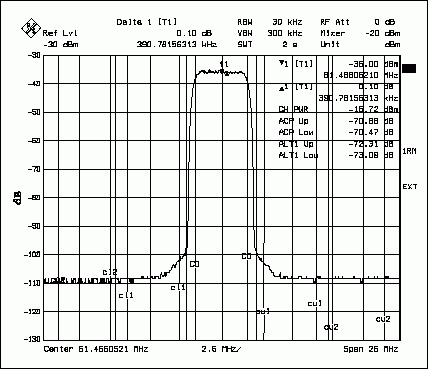
Figure 3. The MAX5888's UMTS ACPR spectral response, shown as a single full-load carrier at an output frequency of 61MHz.
Figure 4 shows the ACPR characteristics of the MAX5888 in a four-carrier UMTS application (this may be the most demanding ACPR of all applications). MAX5888 (it is currently the highest performance solution for this type of application) not only meets the template requirements of -45dBc and -50dBc, but also leaves a margin of more than 20dB.

Figure 4. The UMTS ACPR spectrum response of the MAX5888, shown under test conditions, with four fully loaded carriers centered at 61MHz.
CDMA carrier synthesis has similar performance requirements. The main specification of this architecture is the stray radiation template, which includes ACPR template requirements. The template of this standard is variable and depends on the operating band and the output power of the transmitter. Figure 5 shows an eight-tone system, with each tone separated by 1MHz, and the IF frequency aligned at 30MHz. For the most demanding template combination in different bands, under the assumed 40W transmit power, the spurious radiation template level is -59dBc. Under this worst sinusoidal simulation test condition, the MAX5888 can still meet the CDMA mask requirements with a margin of 19dB.
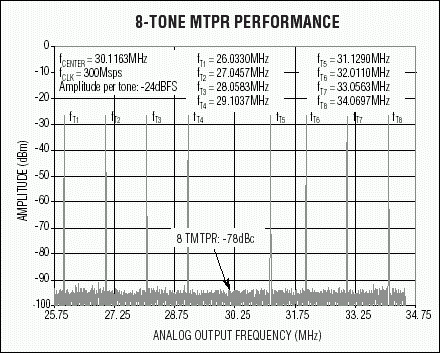
Figure 5. This eight-carrier test vector spectrum shows the excellent multi-tone IMD performance of the MAX5888, which is very suitable for CDMA applications. The selected output frequency is centered at 30MHz.
In the current popular wireless communication system, the dynamic range required by GSM / EDGE is the largest. In the past, multi-carrier transmitters could not be realized due to the limitations of DAC performance, but the MAX5195 broke through this limitation, as shown by the IMD performance when it works with four sine tones separated by 1MHz (Figure 6). Each tone has a carrier level of -18dBFS to avoid clipping of the DAC output signal. The spectrogram covers a 25MHz window with the center at 48MHz.
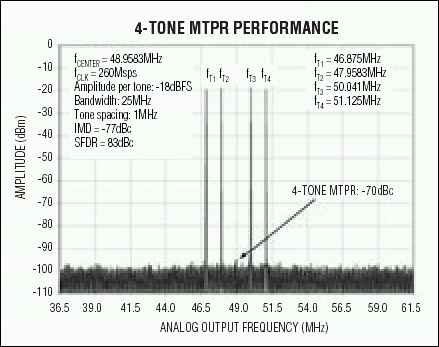
Figure 6. This four-carrier test vector spectrum shows the MAX5195's excellent multi-tone IMD performance, which is very suitable for GSM applications. The output frequency is centered at 48MHz.
The -70dBc boundary of the IMD template is easily satisfied by the MAX5888, with a margin of 8dB. Only a small concession (-15dB relative to full scale) is required in terms of output level, and performance can be improved by 6dB. The SNR of the MAX5888 is as high as -160dB / Hz, which is also ahead of the industry, which makes the device the highest performance device that currently meets the requirements of high standards and multi-carrier GSM / EDGE applications. Conclusion Two DACs from Maxim provide communication system designers with new options in the field of multi-carrier signal synthesis. The MAX5886 / MAX5887 / MAX5888 series combine excellent dynamic performance and low power consumption with a low-noise system-level operating mode. The MAX5195 provides the highest dynamic range at the sampling rate of up to 260Msps, making multi-carrier GSM synthesis a reality.
The higher information bandwidth necessary for modern communication systems to exchange digital information is achieved through a variety of modulation and coding methods, which require wider dynamic characteristics in the transmitter signal processing link. Applications such as UMTS, cdma2000®, and GSM / EDGE also require high dynamic performance, and they are close to the requirement of synthesizing multiple carriers from a single signal generating source.
UMTS requires up to four carriers per transmitter. A single transmitter for GSM / EDGE and cdma2000 may require four to eight carriers. Multi-carrier synthesis requires that the signal channel has a sufficiently wide dynamic range. As the source of this complex modulation waveform, DAC has become a performance bottleneck in the signal path.
UMTS base stations are currently introducing multi-carrier signal synthesis. Therefore, these base stations require the DAC to meet the UMTS standard and leave sufficient surplus. The use of DAC in this application also includes correcting the nonlinearity of the power amplifier by introducing digital predistortion into the signal. This aspect alone will increase the bandwidth requirements of the DAC by three to five times. In this way, the signal bandwidth of four UMTS carriers (up to 100MHz) requires a higher sampling rate and a higher analog output frequency. The MAX5888 with a 500Msps refresh rate is designed for this application. The device's performance definition exceeds the UMTS specification requirements for up to four UMTS carriers.
The accuracy and signal bandwidth of this DAC are also competent for communication systems using high-order QAM. Modulation up to QAM256 requires a wider dynamic range to accurately generate the modulation waveform.
The transmission waveform of the GSM / EDGE system even requires the DAC to provide higher dynamic performance. The synthesis of multi-carrier signals pushes the requirements of SFDR, IMD and SNR to the limit. For these demanding applications, MAX5195 can provide the industry's highest SFDR, SNR and IMD. The generation of instrument signals in DDS applications also requires excellent dynamic performance of the DAC. The MAX588X series (MAX5886 / MAX5887 / MAX5888) and MAX5195 are very suitable for this application. Advantages of the MAX588X series and MAX5195 The DACs of the MAX588X series can provide excellent dynamic performance at a very low power consumption level, with the industry's leading 500Msps maximum sampling rate. At 50MHz output frequency and 400Msps refresh rate, the SFDR of the MAX5888 exceeds 67dBc. In addition, it has excellent SNR (-155dB / Hz) and dual tone IMD (-72dBc) at an output frequency of 80MHz. These characteristics are obtained at a sampling rate of 500Msps, a single 3.3V power supply and very low power consumption (235mW).
Digital data is fed in through the LVDS interface, which has two benefits: LVDS logic can very efficiently support the 500Msps data rate, and the differential input digital signal also helps reduce system noise on the digital interface. This is especially important when designing systems with a wide dynamic range.
The dynamic performance of the MAX588X series is only inferior to the newly introduced MAX5195, as shown in Figure 1, the latter's performance surpasses any other commercially available devices. In addition to its excellent SFDR performance, its SNR also leads the industry at -160dB / Hz, and its dual-tone IMD (87dBc at 32MHz output frequency) is also excellent. The digital interface of this 14-bit DAC is LVPECL, which is similar to LVDS, and also reduces the system noise caused by high-speed digital data transmission.

Figure 1. This SFDR curve compares the MAX5195 with the best competing devices in a certain output frequency range.
All these DACs are available in small QFN packages: the MAX588X series is 68-pin and the MAX5195 is 48-pin. The leadless QFN package has both small size (7mm x 7mm) and good thermal and electrical performance. The exposed pad provides ultra-low ground impedance, which further reduces spurious signals in the output signal. How can these DACs be used in other applications? Let's examine the application of multi-carrier UMTS using digital predistortion technology. This application requires high dynamic performance and a signal bandwidth of 100MHz. The UMTS model for stray radiation requires that the stray components are not greater than -58dBc within the 1MHz measurement bandwidth. Figure 2 shows the output spectrum at 300Msps sampling rate and 60MHz tone output. Devices such as the MAX5888 have sufficient margin in the 100MHz bandwidth of interest (more than 8dB beyond the mask requirement), leaving enough margin for each link in the transmit signal link. Spread spectrum signals can further reduce spurious output and provide more margin for design specifications.

Figure 2. Typical SFDR of MAX5888, shown as 60MHz output frequency and 100MHz bandwidth.
Another important indicator for this application is the adjacent channel power ratio (ACPR). Figure 3 shows the spectral response of a single carrier UMTS with the carrier aligned at 60MHz. It can be seen that it fully complies with the requirements of the ACPR template for the first and second adjacent channels (-45dBc and -50dBc), and has a loose margin of over 25dB.

Figure 3. The MAX5888's UMTS ACPR spectral response, shown as a single full-load carrier at an output frequency of 61MHz.
Figure 4 shows the ACPR characteristics of the MAX5888 in a four-carrier UMTS application (this may be the most demanding ACPR of all applications). MAX5888 (it is currently the highest performance solution for this type of application) not only meets the template requirements of -45dBc and -50dBc, but also leaves a margin of more than 20dB.

Figure 4. The UMTS ACPR spectrum response of the MAX5888, shown under test conditions, with four fully loaded carriers centered at 61MHz.
CDMA carrier synthesis has similar performance requirements. The main specification of this architecture is the stray radiation template, which includes ACPR template requirements. The template of this standard is variable and depends on the operating band and the output power of the transmitter. Figure 5 shows an eight-tone system, with each tone separated by 1MHz, and the IF frequency aligned at 30MHz. For the most demanding template combination in different bands, under the assumed 40W transmit power, the spurious radiation template level is -59dBc. Under this worst sinusoidal simulation test condition, the MAX5888 can still meet the CDMA mask requirements with a margin of 19dB.

Figure 5. This eight-carrier test vector spectrum shows the excellent multi-tone IMD performance of the MAX5888, which is very suitable for CDMA applications. The selected output frequency is centered at 30MHz.
In the current popular wireless communication system, the dynamic range required by GSM / EDGE is the largest. In the past, multi-carrier transmitters could not be realized due to the limitations of DAC performance, but the MAX5195 broke through this limitation, as shown by the IMD performance when it works with four sine tones separated by 1MHz (Figure 6). Each tone has a carrier level of -18dBFS to avoid clipping of the DAC output signal. The spectrogram covers a 25MHz window with the center at 48MHz.

Figure 6. This four-carrier test vector spectrum shows the MAX5195's excellent multi-tone IMD performance, which is very suitable for GSM applications. The output frequency is centered at 48MHz.
The -70dBc boundary of the IMD template is easily satisfied by the MAX5888, with a margin of 8dB. Only a small concession (-15dB relative to full scale) is required in terms of output level, and performance can be improved by 6dB. The SNR of the MAX5888 is as high as -160dB / Hz, which is also ahead of the industry, which makes the device the highest performance device that currently meets the requirements of high standards and multi-carrier GSM / EDGE applications. Conclusion Two DACs from Maxim provide communication system designers with new options in the field of multi-carrier signal synthesis. The MAX5886 / MAX5887 / MAX5888 series combine excellent dynamic performance and low power consumption with a low-noise system-level operating mode. The MAX5195 provides the highest dynamic range at the sampling rate of up to 260Msps, making multi-carrier GSM synthesis a reality.
30-50W Solar Street Lights,30W Solar Street Light,45W Solar Street Light,50W Solar Street Light
Yangzhou Bright Solar Solutions Co., Ltd. , https://www.cnbrightsolar.com